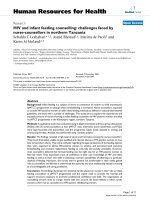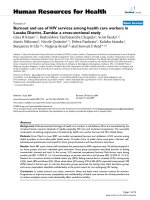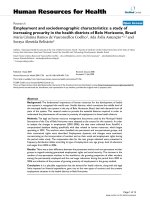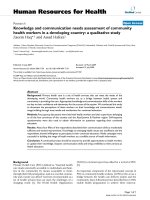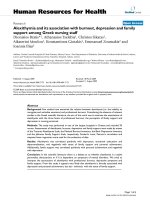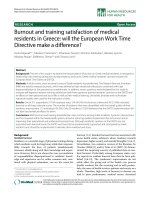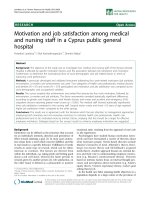báo cáo sinh học:" Employment and sociodemographic characteristics: a study of increasing precarity in the health districts of Belo Horizonte, Brazil" pdf
Bạn đang xem bản rút gọn của tài liệu. Xem và tải ngay bản đầy đủ của tài liệu tại đây (394.3 KB, 13 trang )
BioMed Central
Page 1 of 13
(page number not for citation purposes)
Human Resources for Health
Open Access
Research
Employment and sociodemographic characteristics: a study of
increasing precarity in the health districts of Belo Horizonte, Brazil
Maria Cristina Ramos de Vasconcellos Coelho
1
, Ada Ávila Assunção*
2,3
and
Soraya Almeida Belisário
2
Address:
1
Municipal Health Secretariat of the City of Belo Horizonte, Brazil,
2
Faculty of Medicine of the Federal University of the State of Minas
Gerais, Belo Horizonte, Brazil and
3
National Council for Scientific and Technology Development, Brasília, Brazil
Email: Maria Cristina Ramos de Vasconcellos Coelho - ; Ada Ávila Assunção* - ;
Soraya Almeida Belisário -
* Corresponding author
Abstract
Background: The fundamental importance of human resources for the development of health
care systems is recognized the world over. Health districts, which constitute the middle level of
the municipal health care system in the city of Belo Horizonte, Brazil, deal with demands from all
parts of the system. This research seeks to provide the essential features required in order to
understand the phenomenon of increase in precarity of employment in these health districts.
Methods: The legal and human resource management documents used by the Municipal Health
Secretariat of the City of Belo Horizonte were adopted as the corpus for this research. In order
to analyse the changes in employment (2002–2006), the data were collected from ArteRH, a
computerized database dealing specifically with data related to human resources, which began
operating in 2001. The workers were classified into permanent and non-permanent groups, and
their contractual rights were described. Employment dynamics and changes were examined,
concentrating on the incorporation of workers and on their social and employment rights during
the period under study. The comparative data for the two groups obtained were presented in
frequency distribution tables according to type of employment, sex, age group, level of education
and wages from 2002 to 2006.
Results: There was a clear difference between the permanent worker and non-permanent worker
groups as regards existing guaranteed employment rights and social security. The increase in the
number of non-permanent workers in the workforce, the growing proportion of older workers
among the permanently employed and the real wage reductions during the period from 2002 to
2006 are indicative of the process of growing precarity of employment in the group studied.
Conclusion: It is a plausible supposition that the demand for health reforms, along with the legal
limits imposed on financial expenditure, gave rise to the new types of contract and the present
employment situation in the health districts in Belo Horizonte.
Published: 13 July 2009
Human Resources for Health 2009, 7:56 doi:10.1186/1478-4491-7-56
Received: 22 June 2008
Accepted: 13 July 2009
This article is available from: />© 2009 Coelho et al; licensee BioMed Central Ltd.
This is an Open Access article distributed under the terms of the Creative Commons Attribution License ( />),
which permits unrestricted use, distribution, and reproduction in any medium, provided the original work is properly cited.
Human Resources for Health 2009, 7:56 />Page 2 of 13
(page number not for citation purposes)
Background
The fundamental importance of human resources in ena-
bling health systems to fulfil their aims is recognized the
world over in studies and documents from a variety of
institutions [1,2]. Employment and work protection con-
stitute a fundamental policy to ensure better conditions
for professional development in this sector, and they
interact with the challenges of establishing a new model
for the provision of health care [3].
The standard employment contract or typical job con-
cerns the work carried out for one single employer. The
typical job is based on an agreement made in an employ-
ment contract between employer and employee for work
carried out in a specified place determined by the
employer, for an indeterminate period, with specific tasks
defined and carried out on a continuous, full-time basis
according to the existing employment legislation [4]. A
job without a standard employment contract can be con-
sidered to be precarious.
Precarious jobs are unstable, short-term, offer almost no
possibility of promotion or a career, and have lower remu-
neration and fewer labour rights (holidays, wages, retire-
ment benefits, etc.) in comparison with jobs where there
is a standard employment contract [5-7].
In the world at present, the workforce is distributed une-
qually as regards the conditions of the employment con-
tract, which are connected to different levels of conditions
of work (hours of work, access to information about
workplace hazards, rights during periods of sick leave,
etc.). The negative effects of precarious work on safety at
work and the quality of service provision are well-known
[8,9].
In the case of public institutions, precarious jobs are those
that have been put out to third-party contracts and are
therefore subject only to operational control by managers.
As a result, they do not have the legal rights that a contract
guarantees for those who were selected by means of an
open, competitive examination [10].
The present research seeks to examine the dynamics of
employment and the changes in the health districts (HDs)
of the Municipal Health Secretariat of the City of Belo
Horizonte (MHS-BH), concentrating on an investigation
into the incorporation of workers and the social and
employment rights in place during the period under
study. The HDs, which constitute the middle level of the
municipal health system in Belo Horizonte, must meet
the needs of the primary, secondary and tertiary levels of
health care. The technical and management support
required for carrying out these activities makes up part of
the mission of the technical staff of the district manage-
ment, either via its own professionals or temporary con-
tractors.
This article was written with two aims in mind: (1) to
determine the contractual rights of permanent workers
and non-permanent workers in the HDs; (2) to examine
the profile of the permanent workers and non-permanent
workers in the HDs as regards the composition and distri-
bution of the following variables: sex, age group, level of
education, type of job and the purchasing power of the
salaries earned by doctors, dentists and middle-level tech-
nicians. The results for each of the above-mentioned aims
will be presented in separate sections.
Methods
In order to examine the features of the contracts dealing
with employment protection and the guarantees for spe-
cific social rights of workers as a whole, research was car-
ried out making use of a set of documents dealing with
relevant legal provisions and the management of human
resources in the MHS-BH as its corpus.
As regards the study of the dynamics of the incorporation
of workers, it was decided to describe the demographic
characteristics of employment relating to the group con-
sisting of 724 professionals employed by HDs.
Selection of documents
The data concerning employment protection and guaran-
tees of specific social rights of the workforce as a whole
were obtained from the following documents: rough
drafts of temporary contracts from the MHS-BH, drawn
up in accordance with Municipal Laws 6.833/1995,
7.125/1996, 7.523/1998, 7.645/1999 e 9.011/2005; and
the Statute of Public Service Workers of Belo Horizonte
Trade Union, dealing with direct employment in manage-
ment (Law no. 7169/1996). These contracts deal specifi-
cally with each occupational category in the HD of the
MHS-BH and were analysed separately.
Selection and source of the sampled
The period under analysis (2002–2006) coincides with
the availability of data from ArteRH, a database dealing
specifically with human resources, which began process-
ing operations in 2001. ArteRH keeps an up-to-date regis-
ter of human resources at MHS-BH that is not limited to
any particular type of employment or length of the work-
ing day.
The tables had the following fields: Name, Employment
Roll Number, Address, Telephone, Length of Working
Day, Shift and Weekly Working Hours, as well as informa-
tion about salaries. The data about the remuneration stip-
ulated by contract were obtained from another source in
the MHS.
Human Resources for Health 2009, 7:56 />Page 3 of 13
(page number not for citation purposes)
During the period under analysis, the employment situa-
tion at the head offices of nine municipal health districts
was examined, including managers and their teams, total-
ling 724 persons in 2006. The following occupations of
the staff employed at that time were included in the inves-
tigation: doctors, dentists, high-level technical health staff
(nurses, social workers, psychologists, pharmacists, veter-
inary surgeons, biologists, physiotherapists and occupa-
tional physiotherapists), health inspectors, assistant
health staff (nursing assistants, laboratory assistants and
dental assistants), management assistants, office assist-
ants, doormen, watchmen/(security) security staff, typists,
employees on work experience and health visitors not
employed in their specific area and managers.
Health visitors, workers at the Sterilization Centre at one
of the HDs and drivers were excluded because of the very
different nature of their occupational duties, compared to
those workers directly involved in the end mission of the
HDs.
In order to evaluate the contractual remuneration, it was
decided to select four formally recognized occupational
categories on the staff of the Belo Horizonte Municipal
Authority: doctors, dentists, high-level technical health
staff and assistant health staff. The values analysed refer to
the basic annual salary for each year.
The changes in contractual salaries and related purchasing
power were analysed by means of an income deflator pro-
duced by institutions specialized in the study of employ-
ment in Brazil, which contained three correction factors:
alteration of the reference date, by centring the index on
the first day of the month; alteration of the value for July
1994 because of the change in the unit of currency that
took place at that time; and expansion of the series to peri-
ods prior to its initial date [11].
The correction of nominal salaries is intended to deal with
the salary from any point in time at constant prices and is
justified by the differential changes in prices. This tech-
nique makes it possible to make comparisons between
two moments in time in order to find out whether work-
ers' purchasing power changed during that period.
It was not possible to study the existence and the extent of
multiple employment, since the HR Management Module
in the ArteRH database at the MHS-BH did not contain
this information.
Analysis of the data
Two main categories were used for the analysis of the data:
full-time workers and part-time workers.
According to the Belo Horizonte Municipal Authority
(BHMA) Public Service Worker's Regulations, a perma-
nent worker is someone who is on the staff of the SUS-BH
(National Health Service-Belo Horizonte) (municipal or
municipalized) and was admitted to this service by pub-
lic, competitive examination [12]. Permanent workers can
be employed either full-time or part-time.
A non-permanent worker is someone who holds a politi-
cal appointment (who can be freely hired and dismissed
by whoever appointed him or her), someone who has a
temporary contract, i.e. is subcontracted, is employed to
provide a specific service or is a trainee. Non-permanent
workers can be employed either full-time or part-time.
In order to produce Tables 1 and 2, which present the data
regarding social employment protection, the types of con-
tract were compared on the basis of social and employ-
ment rights. After reading all the documents comprising
the corpus of the research, the aforementioned type of
protection was selected for each of the categories of work-
ers (permanent worker and non-permanent worker). The
non-permanent workers were then classified according to
the entity in which they were employed.
The following variables were analysed: method of admis-
sion, length of working week, holiday entitlements and
length of holidays, 13
th
salary entitlement, medical leave
allowance, validity of the contract or competitive exami-
nation, right to advance notice and annual salary incre-
ment.
The data allowing analysis of the dynamics of employ-
ment will be presented in frequency distribution tables
according to employment rights, type of occupation, sex,
age group, level of education, time of service and remu-
neration for the period 2002–2006.
Results
Social employment protection
Non-permanent workers in HDs can be admitted to pub-
lic service in different ways: (1) by nomination in the case
of political appointments; (2) by application in the case of
temporary contracts offered by the UHS management; (3)
by application in the case of subcontracts; (4) by applica-
tion and interview for trainee contracts. Permanent work-
ers are admitted to public service by public competitive
examination.
The non-permanent health district workers have a 40-
hour working week, except for those on subcontracts,
whose working week is 44 hours long. Trainees and sub-
contractors work for 20 and 30 hours, respectively. For
permanent workers, the workday varies according to the
level of education required by their position: (1) those
Human Resources for Health 2009, 7:56 />Page 4 of 13
(page number not for citation purposes)
holding jobs that demand a university education have a
20-hour working week; (2) other workers have a 30-hour
working week, which can be extended to 40 hours.
Table 1 compares the types of employment rights for the
categories of permanent and non-permanent workers
from 2002 to 2006. The non-permanent, subcontracted
Health District workers are entitled to 30 calendar days'
holiday per year, while those who hold political appoint-
ments have 25 calendar days per year. Employees with
temporary contracts are entitled to 20 calendar days per
year, providing that they have not been absent more than
three times during that same period and their six-month
contract has been renewed. The trainees and subcontrac-
tors have no holiday entitlement. Permanent Health Dis-
trict workers are entitled to 25 calendar days' holiday per
year.
After completing 12 months of work, both the non-per-
manent and permanent Health District workers, except
subcontractors and trainees, receive a 13
th
salary equal to
1/12 of the yearly salary.
The permanent and non-permanent Health District work-
ers are entitled to sick leave for the time necessary for recu-
peration, except for those temporary employees who are
hired on temporary contracts, who are entitled to only a
maximum of two days' leave per month. Subcontractors
and trainees have no sick leave entitlement.
Temporary subcontracted Health District workers have
contracts with unlimited validity, while political appoint-
ees' contracts are valid only for the duration of the politi-
cal mandate. Temporary contracts are valid for six
months, but, at the employer's discretion, can be renewed
Table 1: Types of employment rights for the categories of permanent and non-permanent workers in the UHS-BH, 2002–2006
Employment rights Category of employment
Non-permanent worker Permanent worker
Political appointment Temporary contract Subcontract Trainee Municipal Health
Secretariat of the City
of Belo Horizonte
(SMSA-BH)
Entry Nomination Application Application Selection Public competitive
examination
Working week 40 hours exclusive
contract.
40 hours per week 44 hours 20 hours
(trainee)
30 hours
(subcontractor)
20 hours
or more
Holidays 25 working days 20 days every 12
months
(when less than 3
absences during the
period)
30 calendar days Not specified 25 working days
13th Salary 1/12 year worked 1/12 year worked 1/12 year worked Not specified 1/12 year worked
Sick leave Time necessary for
recuperation
Maximum of 2 days
per month
Time necessary for
recuperation
Not specified Time necessary for
recuperation
Validity of contract or
competitive
examination
Duration of political
mandate
6 months, renewable
4 times
Indefinite 6 months to 2 years
(trainee)
Indefinite
(subcontractor)
Permanent after 730
days worked.
Prior Notice Not specified 15 calendar days 30 calendar days Not specified 30 calendar days
Increase According to Public
Service increments
Not specified Collective
negotiations
Not specified Collective
negotiations
Source: Produced by the authors from data provided by GGTE/SMSA-BH – 2007.
Human Resources for Health 2009, 7:56 />Page 5 of 13
(page number not for citation purposes)
up to four times for periods of six months. Trainees have
contracts that are valid for six months to two years
(depending on level of education). Non-permanent work-
ers' contracts can be revoked at any time at the employer's
discretion. Permanent Health District workers' contracts
become permanent after they have completed 730 days in
their job.
Permanent Health District workers and temporary work-
ers on subcontract are entitled to 30 days' prior notice of
dismissal, while those on temporary contracts are entitled
to 15 days. Health District workers who are political
appointees, subcontractors and trainees are not entitled to
prior notice of cancellation of their contract.
Permanent Health District workers and temporary work-
ers on subcontract are entitled to salary increases via col-
lective negotiation. Salary increases for political
appointees depend on there being increases for public
service workers, while workers on temporary contracts,
subcontractors and trainees are not entitled to salary
increases.
The specific types of leave and other entitlements for
political appointees and permanent workers are shown in
Table 2.
The dynamics of employment
In the period under investigation, the total number of
workers rose from 467 (2002) to 724 (2006), an overall
increase of 55.03%
The total number of non-permanent workers in 2002 con-
sisted of 72 workers; in 2006 this number increased to
292, a growth of 305% during this period. In the same
period the total number of permanent workers grew by
9.36% in 2002, from 395 to 432. In 2004 there were 439
permanent workers, but in 2005 this dropped by 8.13%,
to 406. However, in 2006 this number increased to 432,
representing growth of 6.40% compared to 2005.
It can be seen that during the years from 2002 to 2006
there was an increase in the percentage of non-permanent
workers, which brought it close to the percentage of per-
manent workers (Fig. 1). Table 3 shows the ratio of per-
manent to non-permanent workers in the health districts
in Belo Horizonte during the period 2002–2006.
The ratio in 2002 was 5.49 permanent workers for each
non-permanent worker (395 permanent workers to 72
non-permanent). In 2006, the ratio changed to 1.48 per-
manent workers for each non-permanent worker (432
permanent workers and 292 non-permanent).
Table 2: Leave and other specific rights: political appointees and full-time workers, UHS-BH, 2006
Political appointees Permanent workers
Leave Leave
Maternity Maternity
Adoption Adoption
Infant feeding Infant feeding
Paternity Paternity
Taking care of sick family member Taking care of sick family member
Accident at work Accident at work
Taking care of spouse or partner
Military service
Election candidate
Personal business
Professional training
Entitlement Entitlement
None Retirement
Good attendance bonus
Five-year length of service bonus
Special workday for students
Shorter workday to take care of dependent with special needs
Transport voucher
Meal voucher
Time allowance for decease/death of relatives; blood donation, jury, military or administrative service;
marriage; force majeure; voter registration or military conscription process and designated off-duty periods –
compensation for hours worked in special cases.
Source: Produced by the authors from data obtained from the Belo Horizonte Municipal Authority Internet Site – 2007.
Human Resources for Health 2009, 7:56 />Page 6 of 13
(page number not for citation purposes)
Although there was a 55.03% overall increase in the total
number of health district workers, the relationship
between workers with non-permanent and permanent
contracts changed over the period, indicating a tendency
for greater growth in the former category compared to the
latter.
In the case of distribution according to sex, there was a
predominance of women in 2002 (70.24%). Fig. 2 shows
the distribution of the total number of workers in the
health districts according to sex from 2002 to 2006. The
total number of both non-permanent and permanent
women workers increased more than these categories of
male workers during the period investigated. In 2002
there were 2.90 women for each man and in 2006 there
were 3.24 women per man. A tendency for a reduction in
the ratio between female and male non-permanent work-
ers can be observed from 2005 onwards; this same ten-
dency can be seen for permanent workers from 2004
onwards.
Fig. 3 shows the distribution of the total number of work-
ers according to age group for the period 2002–2006.
During this period there was an increase in the number of
non-permanent workers in all the age groups. In 2006,
79.07% of all the non-permanent workers were between
the ages of 16 to 20, 21 to 30 and 31 to 40.
From 2002 to 2006, there was an increase in the number
of permanent workers of all age groups. In 2006, 76.16%
of the total number of permanent workers were between
the ages of 41 to 50 and 51 to 60.
Over this period there was a decrease in the percentage of
permanent workers in the 21 to 30 and 31 to 40 age
groups and an increase of this category of workers in the
41 to 50 and 51 to 60 age groups. This demonstrated that
permanent workers increasingly tended to come from the
older age groups.
In the case of both the permanent and non-permanent
categories of workers it was found that, in the long term,
there had been a decrease in the number of workers who
had finished primary or secondary education and an
Table 3: Ratio of full-time to part-time workers in Belo
Horizonte health districts, 2002–2006
Year Ratio of permanent to non-permanent workers
2002 5.49:1
2003 3.02:1
2004 2.35:1
2005 2.04:1
2006 1,48:1
Source: Arte-RH – GPAR/GGTE/SMSA-BH – 2002–2006
Percentage distribution of workers in Belo Horizonte health districts according to type of employment contract, 2002–2006Figure 1
Percentage distribution of workers in Belo Horizonte health districts according to type of employment con-
tract, 2002–2006. Source: Arte-RH – GPAR/GGTE/SMSA-BH – 2002–2006
Human Resources for Health 2009, 7:56 />Page 7 of 13
(page number not for citation purposes)
increase in the number of workers who had completed
university education (Fig. 4). However, this trend was
found to be more in evidence in the case of permanent
workers.
During the period under study, there was a drop in the
real salaries of all the occupational categories studied,
especially in the case of non-permanent workers. For per-
manent workers, there was an increase in real salaries of
all the occupational groups in 2004 and 2006, but with-
out returning to the values obtaining in 2002. The real sal-
aries of all the occupational categories of non-permanent
workers dropped by 26.09% between 2002 and 2006. As
regards those in permanent employment between 2002
and 2006, the real salary varied according to occupational
category. It was 2.05% for doctors (Fig. 5), 10.54% for
dentists (Fig. 6), 18.70% for high-level technical health
staff (Fig. 7) and 14.61% for assistant health staff (Fig. 8).
Discussion
The reform of the Brazilian health system increased the
public health liabilities of municipal authorities and
made it necessary to enlarge the workforce in order to
implement the new health policies. Since the Municipal-
ity of Belo Horizonte was obliged to comply with the new
requirements of the Family Health Programme but faced
legal spending limits, it opted to contract for workers by
means of alternatives to the standard employment con-
tract. It is therefore reasonable to suppose that this situa-
tion explains why the increase in the number of workers
was concentrated in the non-permanent category.
There was a rise in the total number of non-permanent
workers, whose contractual rights and employment pro-
tection were reduced. These results are consistent with
data from the Ministry of Health that show that approxi-
mately 800 000 health workers are in precarious employ-
ment, or almost 40% of the workforce in this sector [13].
These data led to Brito's [14] investigation into the three
parts of the public health reforms that had still not been
properly dealt with by management: the employment
contract, work processes and work relations.
In Brazil, about 42% of the urban workforce does not
have a valid standard employment contract [15]. In the
health sector, which is no different from the general situ-
Percentage distribution of workers in Belo Horizonte health districts according to sex, 2002–2006Figure 2
Percentage distribution of workers in Belo Horizonte health districts according to sex, 2002–2006. Source: Arte-
RH – GPAR/GGTE/SMSA-BH – 2002–2006
Human Resources for Health 2009, 7:56 />Page 8 of 13
(page number not for citation purposes)
ation, there has been a rise in the incidence of unregis-
tered wage employment at the social security agencies
[16]. In addition to this, an increase in multiple employ-
ment has been the solution adopted to deal with the low
salaries of this occupational category [17]. Stress and
exhaustion are to be expected as the results of this situa-
tion [5].
Despite the negative features mentioned, the lack of struc-
tural unemployment in the health care sector in Brazil
stands out. Between 1995 and 2000, there was an increase
of 113 351 posts in this sector, representing a net growth
of 13.9%. In 2000, 3.5% of jobs in the formal labour mar-
ket (930 189 posts) were to be found in the health sector.
There was a 50% net rate of growth in employment in the
municipal health sector from 1995 to 2000 [18-20].
Recently there have been studies of the creation of new
jobs brought about by the increased coverage of health
services. The strong potential for formalizing employment
in this sector is also clear when the level of non-perma-
nent or short-term contractual employment is compared
to the average for the Brazilian labour market. In spite of
this, an analysis of the database from the research carried
out by Dedecca et al. [21] showed that in 2000, 23 862 out
of a total of 198 153 doctors had jobs that were not offi-
cially registered; the remainder were distributed among
the categories of employers or self-employed and trainees.
The distribution of occupations among the total of uncer-
tified nursing assistants was as follows: 132 080 with offi-
cial registration; 41 740 employed by the State; 32 305 not
officially registered; 7230 on work experience and 766 in
unpaid posts.
The predominance of women in both the full-time and
temporary categories during the period studied matches
both domestic and international tendencies. At present in
the United States, women constitute 80% of the workforce
in the health sector [22]. In the European Union, the per-
centage of women is around 77% [23].
In 2000, women occupied 73% of the health service jobs
in Brazil [18]. In the metropolitan regions of six Brazilian
cities (Belo Horizonte, the Federal District of Brasília,
Porto Alegre, Recife, Salvador and São Paulo), the profile
of health service workers is similar to this study in that
female workers predominate, they are from age groups
above 25 years and have a high level of education, which
Percentage distribution of workers in Belo Horizonte health districts according to age group, 2002–2006Figure 3
Percentage distribution of workers in Belo Horizonte health districts according to age group, 2002–2006.
Source: Arte-RH – GPAR/GGTE/SMSA-BH – 2002–2006
Human Resources for Health 2009, 7:56 />Page 9 of 13
(page number not for citation purposes)
is frequently at university level. In 2004, health service
workers in Belo Horizonte, the city that is the focus of this
study, represented 5.5% of the economically active popu-
lation, made up principally (73.7%) of women [24].
For Hirata and Préteceille [25] the growing acceptance of
non-permanent work and temporary work is one of the
possible causes of the greater presence of women in the
labour market, because this makes it possible to reconcile
domestic and paid activities, as well as allowing the
employer greater flexibility as regards salaries.
In a study of the feminization of the labour market in gen-
eral, Lavinas [26] questions whether this phenomenon is
the result of changes in the nature of the female labour
force or whether it derives from changes in the dynamics
of the labour market. According to this line of reasoning,
the present trend towards greater flexibility of salaries and
the length of the working day favours women's insertion
into the labour market, but therefore also reflects the
increasing precarity of employment in Brazil. It would not
be an exaggeration to state that, in Brazil, the existence of
a higher level of education among women in comparison
to men might be one of the possible explanatory factors
for the feminization of employment in the health care sec-
tor.
As regards age group, the tendency for the youngest and
oldest groups of permanent workers in the health districts
to increase may result in lack of competence in respond-
ing to job requirements. In general, workers located at the
opposite ends of the age pyramid can be considered to be
less experienced – in the case of the youngest – or the
weakest physically – in the case of the oldest – who are
also less able to adapt, for example, to demands for versa-
tility. If both situations are not adequately dealt with by
human resources management, this may explain such
undesirable consequences as loss of quality in the provi-
sion of services, greater exposure to areas of insecurity and
higher levels of stress [27].
Changes in the percentage of workers employed in Belo Horizonte health districts according to level of education, 2002–2006Figure 4
Changes in the percentage of workers employed in Belo Horizonte health districts according to level of educa-
tion, 2002–2006. Source: Arte-RH – GPAR/GGTE/SMSA-BH – 2002–2006
Human Resources for Health 2009, 7:56 />Page 10 of 13
(page number not for citation purposes)
According to Girardi and Carvalho [18], the average age of
health service workers in Brazil in 2000 was 38. The
authors report that all the occupational categories in
health work show signs of ageing in comparison with pre-
vious years. The same is true in the north-eastern State of
Rio Grande do Norte in 2005 [28].
The fact that non-permanent workers were concentrated
in the 16 to 20 and 31 to 40 age groups might be associ-
ated with young people's greater willingness or ability to
comply with institutional norms and accept lower salaries
[29].
Once again, the data in these findings are consistent with
the national tendencies for the majority of employed
workers to be in the 18 to 24 and 25 to 39 age groups. It
is reasonable to attribute the rise in the rate of participa-
tion of the 60 year-old age group to postponement of
retirement or to retired workers returning to the labour
market as a strategy to replace the loss in family income
resulting from the unemployment of one of its members
[30]. The normal age of retirement in Brazil is 65 to 70.
As regards level of education, a tendency was found for an
improvement in workers' qualifications regardless of the
type of contract. The fact that non-permanent workers are
concentrated among those who have finished secondary
education can be explained by the presence of trainees car-
rying out management functions in the health districts.
Bezerra reports that in the State of Rio Grande do Norte,
Changes in doctors' salaries in Belo Horizonte health dis-tricts, 2002–2006Figure 5
Changes in doctors' salaries in Belo Horizonte health
districts, 2002–2006. Source: Arte-RH – GPAR/GGTE/
SMSA-BH and deflator INPC (IPEADATA)
Changes in dentists' salaries in Belo Horizonte health dis-tricts, 2002–2006Figure 6
Changes in dentists' salaries in Belo Horizonte health
districts, 2002–2006. Source: Arte-RH – GPAR/GGTE/
SMSA-BH and deflator INPC (IPEADATA)
Changes in top-level technicians' salaries in Belo Horizonte health districts, 2002–2006Figure 7
Changes in top-level technicians' salaries in Belo Hor-
izonte health districts, 2002–2006. Source: Arte-RH –
GPAR/GGTE/SMSA-BH e deflator INPC (IPEADATA)
Changes in assistant health worker's salaries in Belo Hori-zonte health districts, 2002–2006Figure 8
Changes in assistant health worker's salaries in Belo
Horizonte health districts, 2002–2006. Source: Arte-RH
– GPAR/GGTE/SMSA-BH and deflator INPC (IPEADATA)
Human Resources for Health 2009, 7:56 />Page 11 of 13
(page number not for citation purposes)
more than 60% of the health sector was made up of work-
ers who had finished secondary education and who were
engaged in management activities or were working as
health assistants [28].
A tendency for there to be an improvement in permanent
workers' qualifications was observed. From 2002 to 2006,
there was a reduction in the total number of permanent
workers who had finished their secondary education and,
in the same period, an increase in the total number of
workers with university-level education. These data are
similar to the data from the "Research into Employment
and Unemployment in Belo Horizonte". According to this
research, there was a rise in the number of employed
workers who had obtained a primary education and an
expansion of the number of workers who have a second-
ary education, thus representing a tendency for an
improvement in employed workers' qualifications [30].
During the period, the real salaries of all occupational cat-
egories in the health districts fell, especially those of non-
permanent workers. In 2004 and 2006, all the occupa-
tional categories in permanent work improved their real
salary, but without regaining the level of 2002. Although
the average salaries in the public services were higher than
those in the private sector, there was a real drop in salaries
in both sectors during the 1990s, thus making it clear that
the labour market in Brazil had become more precarious
[31].
Conclusion
This research describes the changes in employment and
sociodemographic characteristics of the workers in the
health districts of the MHS-BH during the period from
2002 to 2006. The difference between full-time and non-
permanent workers as regards employment rights and
social protection is clear, thus confirming the tendency
towards precarity in the case of part-time employment.
The rise in temporary employment, the tendency for the
ageing of permanent workers and the drop in workers'
purchasing power during the period from 2002 to 2006
are indicative of the process of increasing precarity of
work and justify government policies aimed at reversing
this tendency. Federal management has highlighted the
damage caused by temporary employment contracts to
the smooth operation of the health service [13]. Staff with
stable jobs, recognized technical leadership, professional
dedication and production of knowledge are the
attributes of institutions that have acquired the ability to
provide health care of good quality [32].
In general, non-permanent workers have a lower level of
job security, less control over their hours of work, worse
career prospects and limited access to training and educa-
tion [5].
In Brazil from 1991 onwards, the state apparatus signifi-
cantly degraded working conditions by increasing the pos-
sibility of more flexible employment contracts, profit
sharing, flexible working days (Hour Banks), Sunday
work and cuts in jobs and salaries.
Maintaining
these work practices led to changes in public
regulation of work contracts; on this new basis, part-time
or fixed-term contracts, reduction in the social security
contributions paid by small companies and public youth
employment subsidies were permitted. Along the same
lines, governments reduced investment in the inspection
of work contracts, thus reducing the possibilities of com-
panies being punished for not complying with the law
[33].
As mentioned earlier, the National Health Service did not
escape this situation. The increasing precarity of work in
health care has been a source of concern for managers at
all levels of government and has been a priority agenda
item for the National Council of Municipal Health Secre-
taries [Conselho Nacional de Secretários Municipais de Saúde
(CONASEMS) [34].
In order to reverse this situation, the National Programme
to Reduce Precarity of Work (Programa Nacional de
Desprecarização do Trabalho) was set up in the National
Health Service in order to encourage stable work relations,
guarantee workers' rights and to gradually eradicate the
precarious work relations in this sector. This program pro-
duced publicity materials, helped to set up local commit-
tees, sponsored debates, established a support network,
carried out an investigation of workers in precarious work
situations and encouraged research on the impact of the
Law on Financial Liability (Lei de Responsabilidade Fiscal)
on reducing precarity of work in the National Health Serv-
ice [35].
In the case of Belo Horizonte, various measures were
adopted in order to minimize the situation regarding pre-
carity of work and employment in the National Health
Service-Belo Horizonte. The following items may be men-
tioned: (1) creation of the Health Education Centre (Cen-
tro de Educação em Saúde) in 2005 in order to provide
training courses; (2) teleconferences and other types of
educational methods to make it possible for specialist
professionals to assist those professionals working in the
basic health service to provide treatment for clinical cases;
3) presentation and discussion of the technical topics
most relevant for daily work activities in the health units.
Human Resources for Health 2009, 7:56 />Page 12 of 13
(page number not for citation purposes)
In addition to this, between 2002 and 2006, three public
employment admissions exams were organized to select
personnel for positions in the health service. It is also
intended to organize another of these public admission
examinations for doctors. All non-permanent contracts
for career health professionals are being replaced by per-
manent contracts. To this we can add the law approved in
2007, which awarded salary increases for all the positions
included in the Belo Horizonte Municipal Authority
Health Jobs and Career Plan [36].
In the case of training and development of skills, addi-
tional problems are posed for human resources manage-
ment. Lifelong learning is fundamental to professional
performance and for being able to deal with the effects of
changes in the workplace. Workers who do not have
standard employment contracts may be carrying out func-
tions that fail to make full use of their skills and capacities
[4]. This situation as a whole can cause occupational stress
[5].
These results may serve to guide human resources man-
agement in the sector, considering that the health districts
are essential for the performance and development of the
Unified Health Service in Belo Horizonte. Moreover, the
activity of the workers in this area is of fundamental
importance in bringing about a transformation of health
practices and the quality of service provided to the public
[37,38].
The variety of political, ideological and technical roles
played by workers in the health districts would be
strengthened in an environment where there was greater
employment and work protection. In this regard, qualita-
tive studies would be able to elucidate the effects of the sit-
uation described above and identify the levels of
dissatisfaction found in the sector.
An understanding of the employment profile in the health
districts is the first step towards development of a human
resource policy directed at middle management. It opens
up the possibility of new research into various aspects that
were not dealt with in this study, such as ensuring that
staff members have the correct aptitudes and training for
the demands facing middle management, assessment of
overtime and resizing of (full-time) staff.
Competing interests
The authors declare that they have no competing interests.
Authors' contributions
MC, AA and SB jointly formulated the study design. MC
obtained the data. MC and AA were involved in the con-
ceptualization, initial drafts and final write-up of the
paper. All authors had access to all data in the study and
had final responsibility for the decision to submit this
manuscript for publication.
Acknowledgements
The authors gratefully acknowledge the assistance of Dra. Ana Flavia Mach-
ado, Professor of Demography at the University of Minas Gerais, in analysis
of the data and for her helpful comments and editing.
This research would not have been possible without the assistance of the
Research Support Foundation of the State of Minas Gerais (Fundação de
Amparo à Pesquisa do Estado de Minas Gerais) (FAPEMIG EDT 3339-2006).
References
1. Fritzen AS: Strategic management of the health workforce in
developing countries: What have we learned? Human
Resources for Health 2007, 5:4.
2. Alliance Mondiale pour les Personnels de Sante. Organisation Mondi-
ale de la Santé: Directives: mesures incitatives pour les profes-
sionnels de la santé. 2008:38 [ />workforcealliance/knowledge/publications/alliance/
Incentives_Guidelines%20FR%20low.pdf].
3. Brito PE, Padilla M, RígolI F: Planificación de recursos humanos
y reformas del sector salud. Educação Médica Superior 2002,
16(4): [ />ems09402.htm].
4. Galeazzi IMS: O trabalho por conta própria num contexto de
precarização laboral. In Dimensões da precarização do mercado de
trabalho na Região Metropolitana de Porto Alegre Edited by: Bastos RLA.
Porto Alegre: FEE; 2007:81-151.
5. New forms of contractual relationships and the implications
for occupational safety and health [ />cations/reports/206]
6. Hirata H: Divisão sexual do trabalho: novas tendências e prob-
lemas atuais. In Gênero no mundo do trabalho Fundação SEADE. São
Paulo: Ellus; 2000:188-218.
7. Ramos L, Reis JGA: Emprego no Brasil nos anos 90. Rio de
Janeiro: IPEA; 1997:468.
8. Dussault G, Rigoli F: Dimensiones laborales de las reformas
sectoriales en salud. Sus relaciones con eficiencia, equidad y
calidad. Revista Latinoamericana de Estudios del Trabajo 2002,
8(15):15-45.
9. The changing world of work Magazine of the European Agency for
Safety and Health at Work 2000 [ />magazine].
10. Nogueira RP: Problemas de gestão e regulação do trabalho no
SUS. In Serviço Social e Sociedade Volume 87. São Paulo: CRESS SP/
Cortez; 2006:147-162.
11. Uma sugestão de deflatores para rendas obtidas a partir de
algumas pesquisas domiciliares do IBGE [http://
www.ipea.gov.br/pub/td/2002/td_0897.pdf]
12. Prefeitura Municipal de Belo Horizonte: Lei 7.169, de 30 de agosto de
1996 Institui o estatuto dos servidores públicos do quadro geral de
pessoal do município de Belo Horizonte vinculados à administração
direta, e dá outras providências. Gabinete do Prefeito, agosto; 1996.
13. Ministério da Saúde do Brasil: Para subsidiar a discussão sobre a
desprecarização do trabalho no SUS. Cadernos RH Saúde 2006,
3(1):1-188.
14. Brito P: Impacto de las reformas del sector de la salud sobre
los recursos humanos y la gestión laboral. Revista Panamericana
Salud Publica 2000, 8(1–2):43-54.
15. Ramos L, Ferreira V: Padrões espacial e setorial da evolução da
informalidade no período 1991–2005. Pesquisa e Planejamento
Econômico 2006, 36(3):471-488.
16. Cacciamali MC: Globalização e processo de informalidade.
Economia e Sociedade 2000, 9(1):153-174.
17. Medeiros SM, Rocha SMM: Considerações sobre a terceira rev-
olução industrial e a força de trabalho em saúde em Natal.
Ciência & Saúde Coletiva 2004, 9(2):399-409.
18. Configurações do mercado de trabalho dos assalariados em
saúde no Brasil [
]
19. Machado MH: Trabalhadores de Saúde e sua trajetória na
Reforma Sanitária. In Saúde e Democracia: história e perspectivas do
Publish with Bio Med Central and every
scientist can read your work free of charge
"BioMed Central will be the most significant development for
disseminating the results of biomedical research in our lifetime."
Sir Paul Nurse, Cancer Research UK
Your research papers will be:
available free of charge to the entire biomedical community
peer reviewed and published immediately upon acceptance
cited in PubMed and archived on PubMed Central
yours — you keep the copyright
Submit your manuscript here:
/>BioMedcentral
Human Resources for Health 2009, 7:56 />Page 13 of 13
(page number not for citation purposes)
SUS Edited by: Lima NT. Rio de Janeiro: Editora Fiocruz;
2005:257-280.
20. Cordeiro H: Descentralização, universalidade e equidade nas
reformas da saúde. Revista Ciência & Saúde Coletiva 2001,
6(2):319-328.
21. Dedecca CS, Rosandiski CS, Carvalho EN, Barbieri CV: A dimensão
ocupacional do setor de atendimento à saúde no Brasil. Tra-
balho, Educação e Saúde 2005, 3(1):123-14.
22. Centers for Disease Control and Prevention: National Institute
for Occupational Safety and Health. Health Care Workers 2008
[ />].
23. European Agency for Safety and Health at Work: Safety and Health
Good Practice on-line for the Healthcare Sector 2003 [http://
osha.europa.eu/publications/reports/206].
24. O trabalhador da saúde em seis regiões metropolitanas bra-
sileiras [ />]
25. Hirata H, Préteceille E: La prise en compte de l'insécurité socio-
économique dans les grandes enquêtes statistiques en
France. In BUREAU INTERNATIONAL du TRAVAIL. Exclusion, Précarité,
Insécurité Socio-Économique (Apports et débats des sciences sociales en
France) Genève, Bureau International Du Travail; 2002.
26. Lavinas L: Perspectivas do emprego no Brasil: inflexões de
gênero e diferenciais femininos. In Emprego feminino no Brasil:
mudanças institucionais e novas inserções no mercado de trabalho OIT –
CEPAL/ECLAC. Santiago de Chile; 2002.
27. Froneberg B: National and international response to occupa-
tional hazards in the healthcare sector. Annals of the New York
Academy of Sciences 2006, 1076:607-614.
28. Bezerra O: Dinâmica e características do mercado de tra-
balho do setor saúde em Natal – RN. Observatório RH NESC/
UFRN: Natal; 2006.
29. Rodrigues FS: O segmento de meia idade: análise sobre os
desdobramentos do padrão de acumulação flexível em sua
inserção produtiva. Bahia Análise & Dados 2006, 15(4):579-591.
30. Oliveira AM: Dez anos da Pesquisa de Emprego e Desem-
prego (PED) na região metropolitana de Belo Horizonte
(RMBH): tempos difíceis para os ocupados. In As várias faces do
mercado de trabalho no Brasil Edited by: Januzzi JM, Soares M. Belo
Horizonte: Fundação João Pinheiro; 2006:100-116.
31. Borges AMC: Reforma do Estado, emprego público e a precar-
ização do mercado de trabalho. Caderno CRH 2004,
17(41):255-268.
32. O'Dwyer GC: Trabalho, ética e necessidades sociais em
saúde. Política de recursos humanos em saúde. Brasília: Min-
istério da Saúde; 2002.
33. Dedecca CS: Flexibilidade e regulação de um mercado de tra-
balho precário: a experiência brasileira. In Colóquio Internacional
– Novas Formas do Trabalho e do Desemprego: Brasil, Japão e França
numa perspectiva comparada São Paulo; 2006.
34. CONASEMS: Gestão do trabalho e educação na saúde. Teses e
Plano de Ação 2006 [
].
35. Orientações gerais para elaboração de editais – processo
seletivo público: agentes comunitários de saúde e agentes de
combate às endemias. Brasília: Ministério da Saúde; 2007.
36. Prefeitura Municipal de Belo Horizonte: Edital 02/2007. Diário
Oficial do Município. 2007.
37. Roncalli AG: O desenvolvimento das políticas públicas de
saúde no Brasil e a construção do Sistema Único de Saúde.
In Odontologia em saúde coletiva: planejando ações e promovendo saúde
Volume 2. Edited by: Pereira AC. Porto Alegre: Artmed; 2003:28-49.
38. Malik AM: Gestão de recursos humanos. São Paulo: Faculdade de
Saúde Pública da Universidade de São Paulo; 1998.

